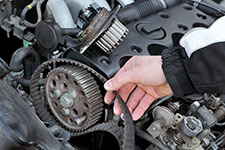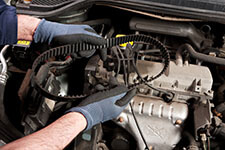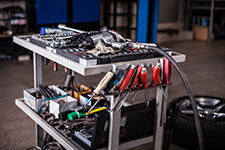What is a timing belt?
The ribbed belt called the timing belt is placed in a very specific way along one side of your engine. Its role is to keep the crankshafts and camshafts timed correctly. Ultimately, it keeps the top half of the engine, which includes the cylinder and valves, synched up with the bottom half composed of the crankcase and pistons.
Do all cars have timing belts?
 If you have an older car, manufactured in the 90's or before, you almost certainly having a timing belt. If you have a newer model, you may still have a timing belt. Some manufacturers still use them. And others have switched over to metal timing chains, which lasts longer. Check your owner's manual to be sure. Even some of the higher end vehicles still use timing belts, so the original price or how technologically advanced your car would not be a good indicator. Guessing is never the answer. Taking the time to do the research is always good.
If you have an older car, manufactured in the 90's or before, you almost certainly having a timing belt. If you have a newer model, you may still have a timing belt. Some manufacturers still use them. And others have switched over to metal timing chains, which lasts longer. Check your owner's manual to be sure. Even some of the higher end vehicles still use timing belts, so the original price or how technologically advanced your car would not be a good indicator. Guessing is never the answer. Taking the time to do the research is always good.
How often do I need to change my timing belt?
Again, check your owner's manual, but every 5 years or 60,000 miles is a good average.
What happens if my timing belt snaps?
A snapped timing belt can leave you stranded. Depending on the configuration of your car, a snap belt could result in:
- Valves and pistons colliding. Without the belt to assure proper timing the moving parts in the engine can attempt to enter the same space at the same time. Since two moving parts cannot occupy the same space at the same time, they will collide and damage each other. Cracks, dents are severe and costly damage to the engine result. Engines that are designed like this are called interference engines.
- No damage. But you're still stranded. Some vehicles are designed so that if the belt breaks the moving pieces do not try to occupy the same space. This is called a non-interference engine. You hope you have one of these. A snapped belt is an issue that immediately needs to be resolved. But your engine is not damaged when it snaps.
Broken Timing Belt Symptoms
- A ticking noise coming from the engine. No, it doesn’t mean your car is running like a Swiss watch.
- An engine doesn't want to turn over.
- Engine misfires
- Oil Leaking in front of the motor
How much will it cost me to replace the belt?
 Including parts and labor, you’re looking at around $500 or more. Before replacing your timing belt, you need to evaluate the value of your car. Click the button below to see what your car is worth.
Including parts and labor, you’re looking at around $500 or more. Before replacing your timing belt, you need to evaluate the value of your car. Click the button below to see what your car is worth.
If your timing belt is snapped, this may indicate that your vehicle is starting to go downhill. And, the costs will only pile up. Before making a repair, you should evaluate the car as a whole to determine if it is worth repairing. If you are "handy" you may also want to consider replacing it yourself.
This will typically cost around $300, as long as you already have all of the tools you need on hand. If you have to buy the tools, doing it yourself would far exceed the cost of having a professional do it. If you do wish to replace it yourself, please be very careful so that you do not hurt yourself or do costly damage to your car. We always recommend you seek out the services of a professional mechanic.
How do I replace a timing belt?
Special Notes
 First, please note that the below instructions are for a front wheel drive vehicle, non-interference engine. Other engine types will vary slightly. If you have a different engine/drive and are not very experienced and able to adapt to your type of engine, you will want to seek out instructions for your specific engine. Maybe just have a professional do it.
First, please note that the below instructions are for a front wheel drive vehicle, non-interference engine. Other engine types will vary slightly. If you have a different engine/drive and are not very experienced and able to adapt to your type of engine, you will want to seek out instructions for your specific engine. Maybe just have a professional do it.
2nd, these are general instructions. You should also review your factory service manual to get details specific to your car since every car is different. These instructions are just to give you an idea of the process.
What you’ll need
- 1/2" Breaker Bar
- 3/8" Ratchet
- 1/2" Ratchet
- 3/8" Assorted extensions
- Open-ended wrenches, assorted
- 3/8" Sockets, assorted
- 1/2" Sockets, assorted
- Hydraulic Jack
- Torx sockets, assorted (mainly for German and some American cars)
- Hex sockets, assorted (mainly for German and some American cars)
- Reverse Torx sockets, assorted (mainly for German and some American cars)
- Timing belt... and remember "you get what you pay for". Cheap ones are available, but unless you want to be doing this again very soon, go for some quality.
- Water pumps, timing belt tensioner, pulleys - In order to replace the belt, you will need to remove other components. You may find that they are worn and need replacement as well. You do not want to have to take everything apart again to replace them, so be ready for worst case scenario to save significant time and avoid wearing out your new timing belt when other parts are not working as they should.
- Antifreeze and distilled water for the cooling system
The Process
- Engage your parking/emergency brake. If you don't have one, put a brick behind each grounded wheel (the back wheels) to avoid a major mishap. *Do not jack up the car until instructed to do so. *
- Place your 1/2" breaker bar on the matching socket size (typically 17-21 mm).
- Turn counter-clockwise to loosen the lugs. Do not remove yet. Get them just loose enough that you can remove them with a regular ratchet.
- Now raise the car. Place your hydraulic jack under the car's frame rail and lift. Assure that the car is stable by using jack stands.
- Remove front wheels.
- Loosen crank pulley bolt, the main pulley on the bottom of the engine. This bolt is very hard to remove, so an air-powered impact gun is recommended.
- Disconnect the negative battery terminal.
- Remove the accessory belts. This can vary by car, so loosen whatever is giving tension to the belt to remove it.
- Remove crank pulley. If it is corroded or melted to the crank, you will need additional tools to remove it. Don't try to force it without the right tools. Or you'll do serious damage. You need a 3-pronged pulley puller, so it may be time to walk to the auto store if you don't have one. Sorry.
- Remove timing covers. They are usually secured with 10 mm bolts. First, the top ones. Some cars require removal of extra pieces. If you must dismount your engine, don't forget to support it with the jack. When dismounted, it will fall to the ground. Boom!!!
- Place engine at "top dead center", where the marks on the cams and cranks are aligned. This is where the #1 is at the tip top of its stroke.
- Remove the timing belt tensioner and timing belt. Once the cams and cranks are aligned, you can take off the timing belt tensioner and the timing belt.
- Remove the pulleys and water pump. Drain the radiator first into a catch pan. Then unbolt and remove the pump. If it is stuck, it's okay to tap it with a rubber mallet. The pulleys will then come off easily after unbolted.
- We're half way there, so pat yourself on the back.
- Remove as much of the old gasket material as possible with a wire brush if needed to clean the connections.
- Put on your new water pump gasket with a thin layer of high-temp gasket sealant.
- Install timing belt. It will have marks on it to match up with the cam and crank. So make sure everything is aligned. There may be some slack in the belt. No worries.
- Install the time belt tensioner. Adjust it until you feel no slack.
- Install the timing covers and crank pulley. You will probably need a torque of 100 ft -lb or greater.
- Install and tension the accessory belts.
- Time to refill the cooling system. That's usually a mix of antifreeze and distilled water. Stop when it's full.
- Connect the negative battery terminal.
- Start the car.
- Blast the heater and let the car heat up to driving temperature. Check coolant in a couple days as it may settle as air is released.
- Replace the wheels. And lower the car. That was fun!!
Or...
Wouldn't it be easier to sell your car if the time and cost to repair just aren't worth your while, especially when you factor in the value of the car? Get a free, no-obligation, guaranteed offer from DamagedCars.com. Whether you own car with seized engine or slipping transmission we make it easy to sell your less-than-perfect car. Click the button below to get your offer, today!
